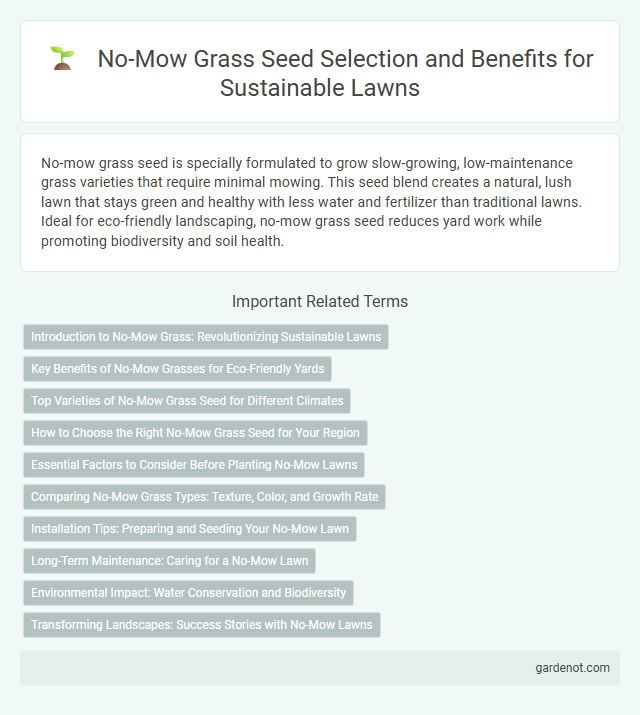No-mow grass seed is specially formulated to grow slow-growing, low-maintenance grass varieties that require minimal mowing. This seed blend creates a natural, lush lawn that stays green and healthy with less water and fertilizer than traditional lawns. Ideal for eco-friendly landscaping, no-mow grass seed reduces yard work while promoting biodiversity and soil health.
Introduction to No-Mow Grass: Revolutionizing Sustainable Lawns
No-mow grass seed offers an innovative solution for sustainable lawns by minimizing mowing frequency and reducing water usage. This low-maintenance grass variety promotes biodiversity and decreases carbon emissions compared to traditional turfgrass species. Homeowners and landscapers embrace no-mow grass for its environmental benefits, drought tolerance, and improved soil health.
Key Benefits of No-Mow Grasses for Eco-Friendly Yards
No-mow grass seed varieties significantly reduce lawn maintenance, conserving water and cutting down on fuel emissions from lawnmowers, promoting eco-friendly yards. These grasses improve soil health by enhancing microbial activity and increasing carbon sequestration, supporting sustainable landscaping practices. Their deep root systems also provide excellent erosion control and create habitats for beneficial insects, contributing to local biodiversity.
Top Varieties of No-Mow Grass Seed for Different Climates
Top varieties of no-mow grass seed include fine fescue blends ideal for cooler climates, offering drought resistance and low maintenance with their shade tolerance. In warmer regions, buffalo grass and zoysia grass stand out due to their heat tolerance and minimal watering needs. For transition zones, a mix of tall fescue and Kentucky bluegrass provides durability and year-round green coverage with reduced mowing frequency.
How to Choose the Right No-Mow Grass Seed for Your Region
Selecting the right no-mow grass seed depends on your region's climate, soil type, and sunlight exposure to ensure optimal growth and low maintenance. Opt for native or drought-tolerant species like fine fescues in cooler zones or buffalo grass in warmer areas to reduce watering and mowing needs. Consulting local agricultural extensions or seed suppliers can provide region-specific varieties that thrive with minimal care.
Essential Factors to Consider Before Planting No-Mow Lawns
Selecting the right no-mow grass seed depends on soil type, climate, and sunlight exposure to ensure optimal growth and durability. Understanding maintenance requirements, such as minimal watering and mowing frequency, is crucial for long-term success and sustainability. Evaluating the seed mix for drought tolerance, pest resistance, and growth rate helps create a resilient, low-maintenance lawn tailored to your environment.
Comparing No-Mow Grass Types: Texture, Color, and Growth Rate
No-mow grass seed varieties such as fine fescues, buffalo grass, and creeping red fescue differ significantly in texture, with fine fescues offering a soft, fine blade and buffalo grass displaying a coarser, sturdier texture. Color variations range from the deep green of creeping red fescue to the blue-green hue of buffalo grass, affecting lawn aesthetics and shade tolerance. Growth rates also vary, as fine fescues grow slowly requiring minimal maintenance, while buffalo grass establishes moderately fast, balancing durability with low mowing needs.
Installation Tips: Preparing and Seeding Your No-Mow Lawn
Prepare the soil by removing existing grass and debris, then loosen the top 2-3 inches with a rake to improve seed-to-soil contact. Spread No-mow grass seed evenly, ideally during cooler seasons like early fall or spring, for optimal germination rates. Lightly water the area daily to keep the soil consistently moist until seedlings establish, typically within 2-3 weeks.
Long-Term Maintenance: Caring for a No-Mow Lawn
No-mow grass seed varieties require significantly less frequent mowing, reducing overall lawn maintenance time and costs while promoting sustainable landscaping. Long-term care focuses on periodic overseeding to maintain thickness, controlled watering to prevent drought stress, and minimal fertilization with slow-release nutrients to support deep root development. This approach enhances soil health, encourages biodiversity, and extends lawn durability without excessive upkeep.
Environmental Impact: Water Conservation and Biodiversity
No-mow grass seed significantly reduces water consumption by eliminating the need for frequent irrigation, promoting sustainable water conservation. Its dense, natural growth pattern supports native pollinators and diverse wildlife, enhancing local biodiversity. This eco-friendly approach minimizes chemical runoff and soil erosion, contributing to healthier ecosystems.
Transforming Landscapes: Success Stories with No-Mow Lawns
No-mow grass seed revolutionizes landscaping by reducing maintenance and promoting ecological balance through drought-resistant, low-growing varieties like fine fescues and buffalograss. Homeowners report remarkable success with lush, weed-resistant lawns that thrive without mowing, conserving water and supporting pollinators. Case studies from diverse climates highlight how no-mow lawns enhance curb appeal while significantly lowering environmental impact.
No-mow grass seed Infographic

 gardenot.com
gardenot.com